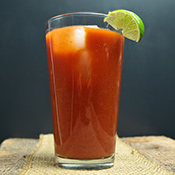We would never suggest you build a still and distill spirits in your own backyard. That would be very much illegal (though we wouldn’t snitch if you did).
The next-best thing: Making your own custom liqueurs. “Of all the possible ‘home-brew’ projects, making liqueur is the most user-friendly,” says Andrew Schloss, author of the new book Homemade Liqueurs and Infused Spirits. “You can have a finished product in as little as a few hours.”
Schloss’s tome features recipes for 159 liqueurs and infusions, including clever replicas of popular brands like Grand Marnier, St-Germain and the cultish artichoke-flavored Cynar. (Schloss admits that his copycats are less nuanced than their inspirations, but you can tweak the recipes to your own personal taste.)
We got the DIY expert to share his tips on making and using liqueurs and infusions, plus two tasty recipes. Find out why you don’t need weeks to make a liqueur, and which one you should be pouring over, yes, roast chicken:
CHOOSE YOUR WEAPON—WISELY
“Vodka is the universal base spirit because it is flavor-neutral,” Schloss says, “but you can get a jumpstart by starting with more flavorful bases.” He recommends whiskey with warm spices, fall fruits or anything with caramel notes—from roasted root vegetables to actual caramel. Rum goes well with most fruits, and gin is good with herbal or floral flavors, as well as “clean vegetables” like cucumber and celery. Or mimic a spirit’s flavor, as in the Smokin’ Liqueur, which combines smoked tea, smoked paprika and smoked pepper with the peaty essence of an Islay Scotch. It packs so much intensity that Schloss simply combines it with vegetable juice to make the complex Bloody Mary variation the Smokin’ Mary.
USE YOUR MATH
Schloss generally recommends a 3-to-1 ratio of liquor to flavoring, which means you’ll need about a cup per 750-mL bottle. Keep in mind that dried ingredients are usually more concentrated than fresh ones, so you’ll need less.
TIMING IS ALL
No need to infuse liqueurs for weeks: Doing so can be detrimental to their flavor. “The first flavors infused into the alcohol are the most volatile—and the most delicious,” Schloss says. Infuse too long and you’ll introduce astringent and bitter flavors. Sample every day or two and stop when you like what you taste. Schloss’ Ruby Slippers Liqueur (pictured above) is a delicate infusion of perfumy rose and tart hibiscus that takes only three to five days to sport just the right level of floral essence. Combined with chardonnay in the Blushing Spritzer, it’s the ideal drink for an afternoon outdoors.
EASY, SWEETIE
Sugar is a must for finishing liqueurs. But Schloss says to take it easy. “Most of the formulas in Homemade Liqueurs are about 25 percent less sweet than commercial products, and 50 percent more flavorful.” he says. That works out to about a cup of simple syrup per bottle of spirit.
GET CREATIVE
Liqueurs, of course, add depth to cocktails. But they can do so much more. Less intense liqueurs are good neat or over ice, and Schloss mixes fruit liqueurs with club soda and herbal ones with tonic. He also drags them into the kitchen: “I use liqueurs as seasonings at the end of cooking: fennel liqueur with seafood, spiced rum with pork, and caramel liqueurs to glaze roasted poultry.” He also drizzles chocolate and coffee liqueurs directly over cake or ice cream. Who needs Magic Shell?

Get the recipe: Smokin’ Mary







